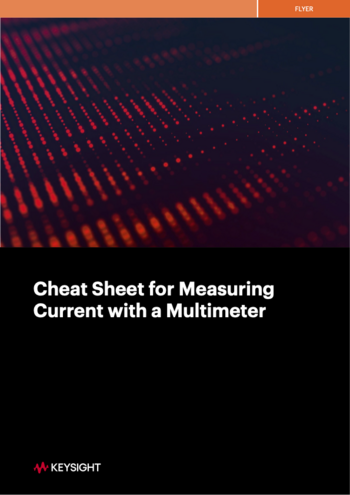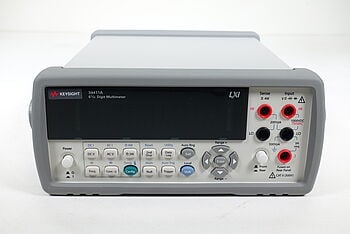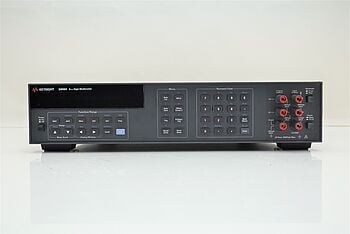- Unlocking the Secrets of Measuring Current with a Multimeter: A Must-Read for Modern Electrical Engineers
- introduction
- The Multimeter: A Versatile Tool
- Importance of Quality and Calibration
- How to Measure Current with Analog Multimeters
- Step-by-Step Guide to Measuring Current
- Common Challenges and Solutions with Analog Multimeters
- Measuring Current with Digital Multimeters
- Step-by-Step Guide to Measuring Current
- Common Challenges and Solutions with Digital Multimeters
- Alternative Current-Measurement Methods
- Clamp Meters
- Oscilloscopes
- Expert Tips for Accurate Current Measurement
- The Safety Aspect: Guidelines and Precautions
- The Hidden Benefits of Buying Used Multimeters
- Cost-Effective without Compromising Quality
- Tested and Certified for Immediate Use
- Environmental Impact
- Explore Keysight’s Range of Precision Multimeters Today
- Conclusion: We Empower Your Electrical Engineering Projects
- Final Key Takeaway: Choose Quality, Choose Precision
- Whenever You’re Ready, Here Are 5 Ways We Can Help You
“Precision is paramount, and a slight miscalculation can cost more than just numbers.” In the world of electrical engineering, current stands as a foundational aspect that dictates functionality, performance, and efficiency. To understand this parameter of electrical flow, engineers rely on a special tool: the multimeter.
The multimeter helps us understand how current works. With it, engineers can tap into the heart of electrical circuits, gauging the ebb and flow of electricity. But using a multimeter isn’t without its challenges. The complexity of measuring current accurately, especially in advanced systems, presents challenges.
Imagine the dismay of an experienced electrical engineer who trusted his multimeter's reading, only to find out he misread the current by a slight margin. A minor mistake led to an entire day dedicated to troubleshooting, serving as a reminder that current measurement is a delicate art, filled with unexpected surprises and complexities. This lesson is well-known among engineers and resonates with anyone who has ever used a multimeter.

 Cheat Sheet for Measuring Current with a Multimeter
Cheat Sheet for Measuring Current with a Multimeter
Download for Free With a Keysight Used Equipment Store Account
The Multimeter: A Versatile Tool
The multimeter serves as an essential tool for measuring current, voltage, and resistance within a circuit. Its ability to gauge current accurately makes it indispensable in the toolkit of engineers. By providing real-time insights into the electrical behavior of components and systems, the multimeter becomes a vital link between the engineer and the electronic world.
But why is it such an essential tool? It's the multimeter's accuracy and adaptability that set it apart. Whether it's a quick check on a prototype or in-depth analysis in a sophisticated system, the multimeter serves as an engineer's guide, delivering essential data with precision.
Importance of Quality and Calibration
But a multimeter is only as good as its quality and calibration. Using a high-quality multimeter means you're less likely to encounter errors, while regular calibration ensures that measurements remain accurate and reliable over time.
Calibration by leading providers like Keysight adds another layer of confidence. Keysight's meticulous calibration processes not only enhance accuracy but also extend the longevity of the tool. By investing in quality multimeters, engineers unlock the full potential of this versatile tool, ensuring that every current measurement hits the mark with precision and reliability.
How to Measure Current with Analog Multimeters
Analog multimeters, though considered traditional in comparison to their digital counterparts, still hold a vital place in today's electrical engineering field. With a needle over a scale to provide readings, analog multimeters offer unique advantages and an appeal that resonates with many professionals.
The key features and benefits of analog multimeters include:
- Analog display: Provides a visual, continuous representation of fluctuations, something that digital displays may not capture as intuitively.
- Durability: Often robust and resilient, especially in demanding environments.
- Simplicity: User-friendly with fewer complex functions, making them suitable for basic measurements.
- Cost-effective: Generally more affordable, catering to budget-conscious users.
- Sensitive to signal changes: Can respond to rapid changes in input, making them ideal for some troubleshooting tasks.
These features highlight the continued relevance and functionality of analog multimeters, even in an age where digital tools dominate.
Step-by-Step Guide to Measuring Current
To measure current with an analog multimeter, follow these steps:
- Turn off the circuit: Safety first! Make sure to turn off the circuit before connecting the multimeter.
- Select the correct range: Set the multimeter to the appropriate current range, usually marked with 'A' for Amperes.
- Choose the right probe: Connect the red probe to the ‘A’ terminal and the black probe to the ‘COM’ terminal.
- Connect in series: Insert the multimeter probes in series with the circuit, where the current is to be measured.
- Turn on the circuit: Restore power, and observe the needle movement on the scale.
- Read the value: Interpret the reading based on the selected range.
- Disconnect safely: Turn off the circuit before removing the probes.
Common Challenges and Solutions with Analog Multimeters
| Challenges | Solutions |
|---|---|
| Difficulty reading the exact value | Use a mirrored scale to minimize parallax errors |
| Incorrect range selection | Always start with the highest range and step down as needed |
| Potential damage due to overload | Utilize overload protection features if available, and always check the circuit first |
The success in measuring current with an analog multimeter lies in understanding its features, adhering to safety precautions, and being mindful of common challenges. Though they may seem antiquated to some, analog multimeters continue to serve as practical tools, offering a visual and nuanced approach to current measurement that still appeals to many electrical engineers.

Measuring Current with Digital Multimeters
Digital multimeters, often referred to as DMMs, are indispensable in modern electrical engineering practices. These sophisticated instruments have largely replaced analog multimeters in many professional settings, offering an array of features and benefits that align with today's technological demands.
The key features and benefits of digital multimeters include:
- Digital display: Presents precise numeric readings, eliminating the guesswork associated with analog scales.
- Versatility: Combines the functions of multiple measuring devices into one, providing convenience and efficiency.
- Accuracy: Generally offers higher accuracy and resolution compared to analog multimeters.
- Data logging: Allows for recording and analyzing data over time, a valuable feature for diagnostics and research.
- Auto-ranging: Automatically selects the appropriate range, simplifying the measuring process.
These features underscore why digital multimeters have become an essential tool for electrical engineers around the globe.
Step-by-Step Guide to Measuring Current
To measure current with a digital multimeter, follow these steps:
- Prepare the circuit: Turn off the circuit and disconnect power before making any connections.
- Set the multimeter: Select the current function, usually denoted by ‘A,’ and choose AC or DC as needed.
- Connect the probes: Insert the red probe into the 'A' jack and the black probe into the 'COM' jack.
- Connect in series: Place the multimeter probes in series with the circuit where you want to measure current.
- Power on the circuit: Turn on the circuit, and read the value displayed on the digital screen.
- Record the reading: If needed, utilize data logging features to save the reading.
- Disconnect safely: Power off the circuit before removing the probes.
Common Challenges and Solutions with Digital Multimeters
| Challenges | Solutions |
|---|---|
| Misinterpretation of display | Refer to the user manual for specific reading instructions. |
| Incorrect function selection | Double-check the selected function and range to match the measurement needs. |
| Battery or power issues | Maintain regular battery checks or use an AC-powered model. |
Digital multimeters have revolutionized the way electrical engineers interact with current, offering advanced capabilities that enhance precision, efficiency, and understanding. By following these steps and being mindful of common challenges, engineers can leverage digital multimeters to their full potential, making them an irreplaceable asset in contemporary electrical engineering.
Alternative Current-Measurement Methods
Current measurement is multifaceted, and while multimeters (both analog and digital) play a pivotal role, other techniques and tools provide alternatives, each with its unique advantages. Understanding when to use these alternative methods versus traditional multimeters can widen the scope of current measurement, offering flexibility and precision in various scenarios.
- Multimeters: Ideal for general-purpose measurements, offering both analog and digital options for a wide range of applications.
- Clamp meters: Suitable for measuring high current without breaking the circuit, often used in industrial settings.
- Oscilloscopes: Preferred for analyzing current waveforms, capturing transients, and in-depth analysis in research and development.
Clamp Meters
Clamp meters function by clamping around a conductor to measure current without making direct contact or interrupting the circuit. They offer the following advantages:
- Non-intrusive measurement: Allows for quick and safe current readings without disconnecting wires.
- High current capability: Capable of measuring very high currents, often beyond the range of traditional multimeters.
- Ease of use: Provides a practical solution for tight or confined spaces.
Clamp meters are particularly useful in industrial and commercial environments where high current flows and safety considerations demand a non-invasive approach.
Oscilloscopes
Oscilloscopes, while not primarily designed for current measurement, can provide detailed insights into current behavior by visualizing waveforms. They are preferred in the following scenarios:
- Waveform analysis: Allows for viewing the shape, frequency, and other characteristics of a current waveform.
- Transient capture: Can capture and analyze short-lived or transient current events that might go unnoticed with a multimeter.
- Research and development: Essential in the design and testing phase, offering a graphical representation of current behavior.
An oscilloscope might require a current probe or other accessories to measure current, and it is often used in laboratories, research facilities, and specialized industrial applications where detailed current analysis is needed.
These alternative methods augment the traditional use of multimeters, offering specific benefits that cater to diverse needs and applications. By understanding these alternatives, electrical engineers can select the most suitable method for each scenario, enhancing the effectiveness and precision of current measurement practices.
Expert Tips for Accurate Current Measurement
Accurate current measurement isn't just about having the right tool; it involves a combination of best practices that ensure reliability and precision. Whether you're using a traditional multimeter, clamp meter, oscilloscope, or another method, these expert tips can guide you to accurate and consistent current readings:
- Choose the right tool: Select the appropriate device based on your needs. Consider factors such as range, resolution, accuracy, and specific application requirements.
- Understand your equipment: Familiarize yourself with the functionalities and limitations of your chosen tool. Refer to the user manual for proper guidance.
- Use proper calibration: Regular calibration by recognized service providers like Keysight ensures your tool stays accurate over time. Don't overlook this essential maintenance routine.
- Mind the connection: When using a multimeter, always connect in series for current measurement. Understanding the connection method is vital, especially with different tools.
- Observe safety precautions: Always adhere to safety guidelines. Turn off the circuit when making connections, use appropriate protective gear like safety glasses and follow manufacturer safety recommendations.
- Select the correct range and settings: Use auto-ranging if available or manually select the right range to match your measurement. Incorrect settings can lead to inaccurate readings or even damage to the tool.
- Avoid parallax errors with analog multimeters: Read the needle over the mirrored scale to minimize reading errors, a crucial point with analog devices.
- Consider environmental factors: Temperature, humidity, and other environmental aspects can affect readings. Be mindful of these variables, especially in critical measurements.
- Use proper accessories: Using the right probes, clamps, or other accessories designed for your specific tool enhances accuracy and safety.
- Inspect your equipment regularly: Check for wear and tear, damaged leads, or other issues that could compromise measurement accuracy.
- Learn from experience and training: Continuously build on your skills and knowledge. Training and real-world experience complement each other, leading to more confident and accurate measurements.
By following these tips and understanding the principles behind accurate current measurement, you can navigate the complexities of current measurement with confidence. It's not merely about following steps but developing a comprehensive approach that recognizes the nuances of current measurement, ensuring that you're not only measuring but truly understanding the invisible force that drives the world of electronics.

The Safety Aspect: Guidelines and Precautions
Safety is paramount when measuring current, especially when dealing with potentially hazardous electrical environments. Whether using an analog or digital multimeter, adhering to safety guidelines and precautions ensures that both the user and the equipment remain protected.
Universal Safety Checklist for Measuring Current:
- Turn off the circuit: Always disconnect power before making connections to prevent accidental shocks or short circuits.
- Use the right tools and equipment: Select probes, leads, and accessories rated for the specific voltage and current you are working with.
- Inspect equipment regularly: Check for any damage, wear, or defects that could compromise safety.
- Wear appropriate personal protective equipment (PPE): This may include safety gloves, eye protection, or other safety gear.
- Avoid working alone in high-risk environments: Having a colleague nearby can be crucial in an emergency.
- Adhere to manufacturer's guidelines: Follow the instructions and recommendations provided by the equipment's manufacturer.
- Mind your surroundings: Be aware of the environment, including wet or confined spaces that might pose additional risks.
- Don't override safety features: Multimeters often come with safety features like fuses or overload protection; do not bypass them.
The act of measuring current, while seemingly simple, requires meticulous attention to safety. Both seasoned professionals and newcomers must never underestimate the potential risks involved. Following these guidelines and precautions creates a foundation for responsible and safe current measurement, reinforcing the principle that safety always comes first in the world of electrical engineering.
The Hidden Benefits of Buying Used Multimeters
In a world where cutting-edge technology often takes center stage, the prospect of buying used multimeters may be overlooked. However, used multimeters present hidden benefits that can be particularly appealing to both professionals and hobbyists. From cost savings to environmental impact, these benefits reinforce the viability of used equipment in modern electrical engineering.
Cost-Effective without Compromising Quality
Keysight's used multimeters provide a cost-saving opportunity without sacrificing the functionality or accuracy for which the brand is known. Key highlights include:
- Same functionality and accuracy: Used Keysight multimeters undergo rigorous testing and calibration to meet the required standards, mirroring the performance of new units.
- Availability of top models: Used Keysight multimeters offer access to high-end models at a fraction of the price.
- Warranty options: Keysight provides the same warranty as a new instrument, reinforcing confidence in the purchase.
Tested and Certified for Immediate Use
Unlike some new units, used Keysight multimeters are always tested, certified, and ready for immediate deployment. Benefits include:
- Elimination of factory defects: Keysight's thorough testing ensures that any potential factory defects have been addressed.
- Time savings: Pre-calibrated and tested Keysight units allow for immediate use upon purchase.
- Professional certification: Keysight offers certificates of calibration and testing for used multimeters, ensuring compliance with industry standards.
Environmental Impact
Opting for used Keysight multimeters also reflects a commitment to sustainability, with positive implications for the environment:
- Reduced electronic waste: Extending the life of a multimeter diminishes electronic waste, contributing to environmental conservation.
- Smaller carbon footprint: Utilizing pre-owned equipment lowers manufacturing demand, thus reducing energy consumption and emissions.
Explore Keysight’s Range of Precision Multimeters Today
Conclusion: We Empower Your Electrical Engineering Projects
In the world of electrical engineering, understanding how to accurately measure current is a fundamental skill, and the multimeter is the indispensable tool that enables it. This article has guided you through the intricacies of measuring current, highlighting the value of both analog and digital multimeters. It has explored the importance of quality, calibration, safety, and the hidden benefits of purchasing used equipment.
By embracing the precision and versatility offered by multimeters, you can elevate your projects and innovation to new heights. Mastering current measurement with a multimeter is important for both experienced professionals and aspiring engineers. Unlock your potential with precision; the multimeter is your key to success in the dynamic field of electrical engineering.
Final Key Takeaway: Choose Quality, Choose Precision
In the intricate and demanding field of electrical engineering, the quest for quality and precision is non-negotiable. It's not merely about choosing a tool; it's about investing in accuracy, reliability, and excellence. Keysight's multimeters embody these values, offering state-of-the-art technology and unwavering support. From new to rigorously tested used models, Keysight's Used Equipment Store ensures that every multimeter in their lineup meets the stringent standards required by modern electrical engineers.
Our commitment extends beyond the product itself, encompassing comprehensive support, calibration services, and educational resources tailored to enhance your understanding and mastery of current measurement.
When you choose Keysight, you're aligning with a legacy of precision and innovation that resonates with professionals across the globe. Choose quality, choose precision, choose Keysight, and let their multimeters be the key that unlocks your full potential in this dynamic and ever-evolving field.

 Cheat Sheet for Measuring Current with a Multimeter
Cheat Sheet for Measuring Current with a Multimeter
Download for Free With a Keysight Used Equipment Store Account
Whenever You’re Ready, Here Are 5 Ways We Can Help You
- Browse our premium used network analyzers, oscilloscopes, signal analyzers and waveform generators.
- Call tech support US: 1 800 829-4444 Press #, then 2. Hours: 7 am – 5 pm MT, Mon– Fri
- Talk to our sales support team by clicking the icon (bottom right corner) on every offer page.
- Create an account to get price alerts and access to exclusive waitlists.
- Talk to your account manager about your specific needs.













































